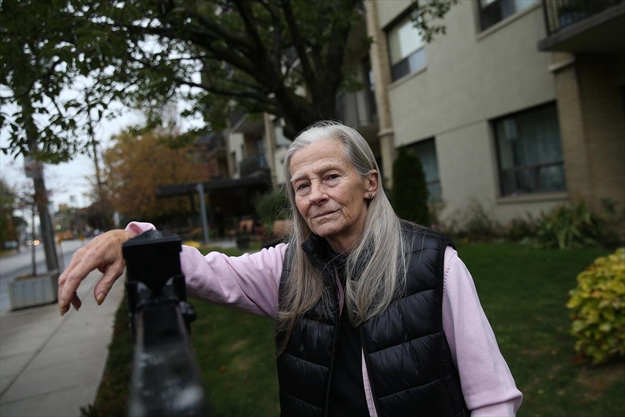In a seniors housing building in east-end Toronto, 69-year-old Maureen Clohessy has taped over her power outlets, hoping to keep bedbugs out of the bachelor unit she’s called home for three years.
Each day, she watches for the scuttling critters, her eyes scanning from her plugs to her ceiling in an apartment on the seventh floor. The building at 828 Kingston Road is known as Glen Stewart Acres, and it’s one of several senior-specific buildings operated by the Toronto Community Housing Corporation.
Like other community housing buildings in Toronto, Glen Stewart Acres has battled pests from bedbugs to rodents and cockroaches. The housing operator saw a leap of 17.4 per cent in demands for pest treatments across all their buildings last year. Clohessy’s building was supposed to be treated top-to-bottom this spring. But then the pandemic hit — and the process was put indefinitely on hold.

“Currently, I have no nests,” Clohessy said, with some relief. But she described a neighbour down the hall walking around with bedbugs clinging to their clothes. Knowing the pests had reached a level where a full building treatment was warranted, but didn’t happen, has left tenants feeling helpless, she said.
“It’s nerve wracking,” she added. “You’re looking every day. It’s like you’re on a mission.”
Community housing said it has received fewer requests for pest control this year than last, which spokesperson Bruce Malloch said is believed to be connected to tenants fearing potential exposure to COVID-19 — though he also reported an uptick in requests after the province moved into Stage 3.
Some tenants who previously made requests to deal with pests had asked for treatment to be moved to another date for safety reasons, Malloch added.
A report submitted for a July meeting of TCHC’s board showed demand for 2,199 pest treatments in April of this year, at the start of the pandemic, versus the 5,141 requests in April last year.
Clohessy acknowledged that during COVID-19 there were residents who were reluctant to ask for someone to come into their units. But she believes that only allows the bedbug problem to get worse, and that it’s a reason to enforce a whole-building pest treatment.
“That way, everyone gets it done whether you like it or not,” she said.
TCHC said it has still provided treatments upon request for specific units during the pandemic, and that there were 261 work orders for pest management across Glen Stewart Acres’ 147 units from February to mid-October — with those work orders including a range of unit visits from inspections to the actual treatment application sessions.
No tenant who requested pest control for their apartment was refused treatment, Malloch said.
But he pointed to public health concerns, and the risks to seniors especially if they caught COVID-19, as reasons for pausing all full building treatments when the pandemic struck — including the one planned at Kingston Road. Responding to pest issues at the unit level, TCHC believes, avoids having mass movement among staff, pest management vendors and tenants who would need to vacant their units for several hours at a time.
Clohessy rejects the housing provider’s logic. “We all know that safety precautions need to be taken. As seniors, we’re more aware of that than anyone. We’re the ones at the highest risk,” she said.
She questioned why it would be less safe for contractors to treat the entire building than individual units, if those contractors were masked and took proper precautions.
In a one-bedroom unit on the second floor of Glen Stewart Acres, 68-year-old Steven Briggs has taken matters into his own hands, buying a steam machine and scattering a powder he found at Home Depot advertised as a killer for bedbugs and crawling insects. “That’s the stuff that works the best,” he said.
Since he moved into the building roughly eight years ago, he said the bugs have been a nightmare. Sometimes it gets a little better, he noted, but then the scales will tip back the other way. He said he’d grown up in a Regent Park social housing complex, but can’t remember ever seeing bedbugs there.
“Cockroaches once in a while, but we took care of them or they brought guys and they got rid of them.”
He believes treating units one by one is ineffective, and allows the pests to simply move to another unit. “They just might as well burn the money that they’re spending on it,” he said.
June Nagle, a resident in her 80s living on the building’s fourth floor, agreed with Malloch that distancing might be tricky with a full-building treatment, though she suggested that they could make use of a rec room to spread residents out.
But she’s skeptical that even a full-building treatment can rid Glen Stewart Acres of bedbugs entirely. Her unit was sprayed repeatedly last year, she said, and she eventually had to throw out a couch and a carpet that were riddled with them.
About a week ago, she said three bedbugs reappeared in her unit — one in her bed and two in her bathtub. Nagle stresses about potential infestations, checking her bed each night and waking at any tickle in her legs.
“You don’t sleep properly. You don’t sleep at all,” she said.
“It’s an ongoing battle in here.”
Victoria Gibson is a Toronto-based reporter for the Star covering affordable housing. Her reporting is funded by the Canadian government through its Local Journalism Initiative. Reach her via email:
